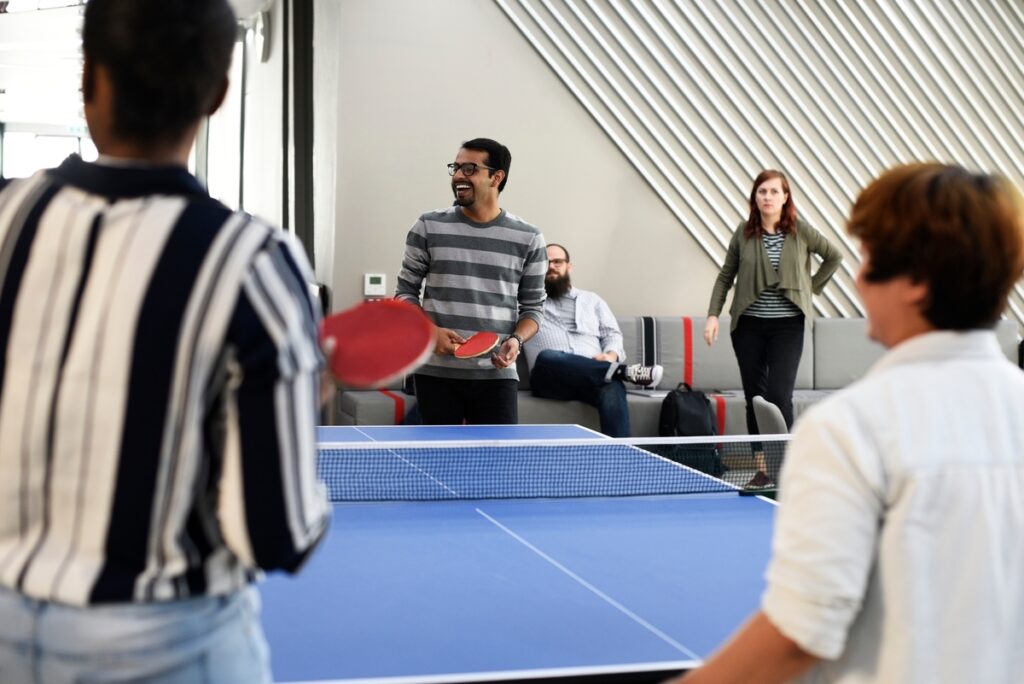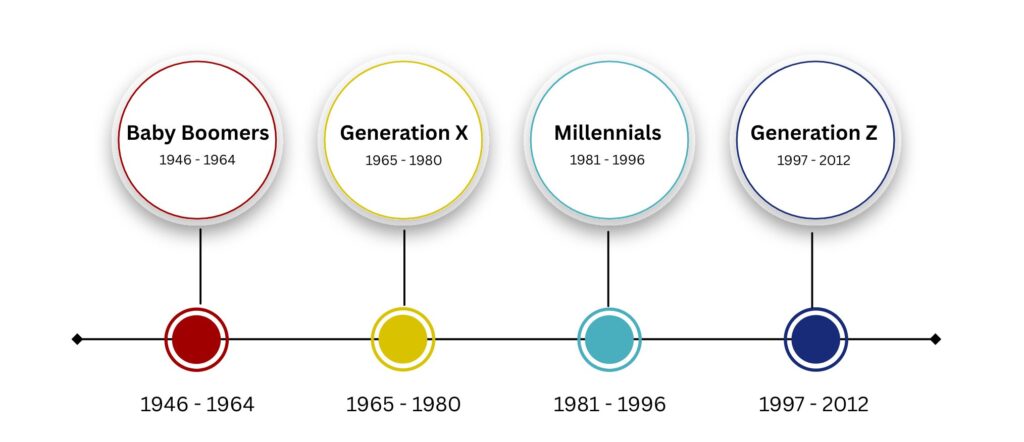The workforce has never been more diverse in age. Baby Boomers, Gen X, Millennials, and Gen Z all work side by side, bringing unique values, wellness needs, and workplace expectations. A wellness program that resonates with a 25-year-old may fall flat for a 55-year-old. Yet running four separate programs is unsustainable. For HR leaders, this raises a critical challenge: how do you design a wellness program that resonates across generations without running four separate initiatives?
The answer is a generational wellness program – a flexible, incentive-driven system that adapts to each age group while staying unified, scalable, and easy to manage. Done right, it boosts employee engagement, reduces burnout, and ensures every dollar spent delivers measurable ROI.
Table of Contents
- What Is a Generational Wellness Program?
- Defining the Generations (and Their Wellness Needs)
- Why a Generational Wellness Program Matters
- What Employees Want by Generation
- Cross-Generational Challenges Every Employer Must Address
- How to Design a Generational Wellness Program
- Why Incentives Drive Engagement Across Generations
- Proof in the Data: Real Participation, Real ROI
- Conclusion: Building Programs that Work
- FAQs About Generational Wellness

What is a Generational Wellness Program?
A generational wellness program is a workplace wellness initiative designed to support multiple generations within the same workforce. Rather than offering one-size-fits-all perks or creating fragmented programs by age group, organizations provide a unified, flexible platform that lets employees choose what works best for them.
This approach ensures:
- Inclusivity: Every employee, from Gen Z to Baby Boomers, can find relevant wellness options.
- Efficiency: HR manages one system instead of juggling multiple vendors or programs.
- Engagement: Employees connect with activities that align with their values and life stage, from preventive screenings to mindfulness to financial wellness.
Defining the Generations (and Their Wellness Needs)
Each generation in the workforce brings its own experiences, values, and health priorities. Understanding these differences is the first step in designing a wellness program that feels relevant and inclusive. While no two individuals are the same, generational trends highlight patterns HR leaders can use to tailor their programs.
- Baby Boomers (1946-1964)
- Generation X (1965-1980)
- Millennials (1981-1996)
- Generation Z (1997-2012)

Baby Boomers (1946-1964)
Boomers are often defined by loyalty and work ethic. Many are extending their careers, but health concerns and retirement planning shape their needs.
- Values: Job security, recognition, and teamwork.
- Wellness needs: Preventive screenings, chronic condition management, financial stability.
- Challenges: Higher risk of diseases like heart disease, diabetes, and cancer.
Generation X (1965-1980)
Known as the “sandwich generation,” Gen X balances careers with caring for children and aging parents, making work-life balance crucial.
- Values: Autonomy, flexibility, and efficiency.
- Wellness needs: Stress reduction, sleep support, financial planning for family and retirement.
- Challenges: High stress from multiple responsibilities, frequent burnout.
Millennials (1981-1996)
Millennials are digital natives who seek purposeful work and holistic benefits. They want employers who prioritize well-being as much as productivity.
- Values: Purpose, collaboration, and growth opportunities.
- Wellness needs: Holistic programs including mental health, fitness, nutrition, and financial wellness.
- Challenges: Burnout, student debt, and economic stress.
Generation Z (1997-2012)
The newest workforce entrants are tech-savvy, socially conscious, and deeply concerned about mental health. They expect inclusive, tech-enabled programs.
- Values: Diversity, flexibility, and financial stability.
- Wellness needs: Mental health support, stress management, fitness and nutrition programs.
- Challenges: Highest rates of anxiety and depression, financial insecurity from rising debt and low entry-level pay.
Why a Generational Wellness Program Matters
Modern workforces are more age-diverse than ever. In fact, five generations are now working side by side for the first time in history. Each group has different values, stressors, and wellness expectations, and failing to account for those differences risks alienating key segments of your workforce.
For example, Burnout is common across generations, but its triggers vary. Gen Xers may feel drained by caregiving responsibilities on top of their careers, while Gen Z struggles with financial insecurity and rising mental health concerns. A one-size-fits-all wellness program may miss these nuances, leaving employees disengaged.
By designing a generational wellness program, HR leaders can:
- Boost Relevance and Participation
- Strengthen Retention
- Reduce Costs Over Time
- Support DEI and Inclusion Goals
Boost Relevance and Participation
Programs that reflect employees’ actual needs have consistently higher engagement. On IncentFit’s platform, participation averages 60% (double the industry norm) because activities span everything from therapy to volunteering, not just gym time.
Strengthen Retention
Research from Gallup shows employees who feel their employer cares about their well-being are 69% less likely to leave. This is especially important for younger generations, who change jobs more frequently.
Reduce Costs Over Time
Preventive care incentives and stress-management initiatives lead to fewer sick days and reduced claims. For example, one study found that financial incentives boosted preventive screening rates within three months.
Support DEI and Inclusion Goals
A program that adapts to all generations demonstrates cultural responsiveness and ensures everyone has equitable access to wellness support.
By tailoring wellness initiatives to generational needs, HR leaders not only drive participation but also strengthen retention and productivity. This is particularly important in competitive job markets, where benefits often tip the scales in recruitment decisions.
What Employees Want by Generation
Designing wellness programs that resonate starts with understanding what employees want by generation. While no two people are identical, patterns emerge in how Baby Boomers, Gen X, Millennials, and Gen Z approach work, wellness, and benefits. For HR professionals, recognizing these differences is critical to building programs that feel personal, not generic.
| Generation | Values & Work Style | Wellness Needs | Challenges | HR Program Implications |
| Baby Boomers 1946 – 1964 | Team-oriented, value loyalty, recognition, and structured environments. | Preventive screenings, chronic disease management, financial counseling. | Higher prevalence of chronic conditions, less comfortable with tech tools. | Offer preventive care incentives, simple digital options, and financial planning benefits. |
| Generation X 1965 – 1980 | Independent, pragmatic, value autonomy and flexibility. | Stress management, sleep support, family-inclusive wellness. | Burnout, financial pressures from caregiving and retirement planning. | Provide flexible challenges, PTO incentives, and family-friendly wellness perks. |
| Millennials 1981 – 1996 | Purpose-driven, collaborative, growth-focused. | Mental health, holistic wellness, financial wellness. | Burnout, student debt, economic stress. | Offer holistic programs (mental, physical, financial) with growth-oriented rewards. |
| Generation Z 1997 – 2012 | Tech-savvy, value diversity, equity, and flexibility. | Mental health support, fitness/nutrition, digital-first wellness. | High anxiety/depression rates, financial insecurity, career uncertainty. | Prioritize mental health, gamified challenges, and inclusive, mobile-first tools. |
Overcoming Cross-Generational Challenges
Even with the best intentions, HR leaders face common roadblocks when implementing a generational wellness program. Addressing these challenges head-on ensures smoother execution and stronger results.
- The Digital Divide
- Engagement Drop-Off
- Budget Constraints
- Communication Gaps
The Digital Divide
While Gen Z and Millennials are comfortable with tech-driven programs, Baby Boomers may feel excluded by app-based solutions. The fix:
- Provide both mobile and desktop access.
- Offer offline participation options (like QR codes or self-reporting).
- Include onboarding sessions to help employees navigate new tools.
Engagement Drop-Off
Wellness programs often start strong but lose momentum. Sustained engagement requires:
- Rotating challenges throughout the year to keep things fresh.
- Celebrating early wins to build confidence.
- Using behavioral science principles like immediacy and loss aversion (employees respond more strongly when they see rewards right away, or when they know what they could miss).
Budget Constraints
Nonprofits and small firms may feel wellness is too costly. Yet programs don’t need to be bloated to be effective. Options like lifestyle stipends, step challenges, and preventive care incentives are affordable starting points, and can be scaled as budgets grow.
Communication Gaps
Different generations prefer different communication styles: Boomers may want email reminders, Gen X may prefer dashboards, Millennials and Gen Z respond better to push notifications or in-app alerts. Using multiple communication channels ensures everyone stays informed and engaged.

How to Design a Generational Wellness Program
The good news: you don’t need separate programs for each generation. Instead, focus on building a modular wellness platform that allows employees to engage in ways that matter to them. It all comes down to flexibility, variety, and meaningful incentives.
Here’s how HR leaders can design inclusive programs:
- Offer a Menu of Activities
- Leverage Technology
- Pair Incentives with Generational Priorities
- Make It Inclusive and Accessible
- Simplify the Admin Side
Offer a Menu of Activities
Employees of all ages want flexibility, but the activities they choose may differ. A strong wellness program lets employees pick from a variety of options, whether it’s gym visits, therapy sessions, mindfulness apps, or preventive screenings.
- Baby Boomers may lean toward preventive care reimbursements or screenings.
- Gen X may prefer stress management or family-inclusive benefits.
- Millennials often prioritize holistic perks like nutrition programs or financial wellness support.
- Gen Z expects access to digital-first wellness apps and instant rewards.
On IncentFit, 70% of activities logged happen outside of gyms – proof that broader options drive real engagement.
Leverage Technology
Technology bridges the generational gap, but it can also widen it. While Gen Z thrives on app-driven wellness, Baby Boomers may prefer simple, user-friendly tools. That’s why programs need both: seamless app integrations for younger employees, paired with straightforward, accessible platforms for older generations.
IncentFit, for example, integrates with 35+ apps and devices (from Apple Watch to Samsung Health), while still offering easy reimbursement options for those less digitally inclined.
Pair Incentives with Generational Priorities
Employees are motivated differently by rewards. For example:
- Boomers value financial security → premium offsets, HSA contributions.
- Gen X prioritizes work-life balance → PTO incentives.
- Millennials seek holistic perks → fitness stipends, wellness challenges.
- Gen Z thrives on recognition and choice → instant cash rewards, gamification.
When rewards align with what people actually want, engagement and satisfaction increase dramatically.
Make It Inclusive and Accessible
An inclusive program ensures everyone can participate regardless of age, ability, or background. This might mean offering low-impact challenges (like hydration or meditation) alongside higher-intensity ones (like running or cycling). Wellness programs should cover:
- Mental health (therapy, mindfulness apps, stress management).
- Physical health (fitness rewards, preventive screenings).
- Financial wellness (tuition support, retirement planning, debt management).
- Social well-being (team challenges, volunteering rewards).
This ensures that no matter where employees are in life, they can find meaningful support.
Simplify the Admin Side
Generational wellness programs can sound complex, but they don’t have to be. Platforms like IncentFit automate activity verification, reward disbursement, and reporting, so HR teams can manage everything in minutes instead of hours.
Why Incentives Drive Engagement Across Generations
No matter the generation, incentives work. But the way employees respond to them can differ – making it essential for HR leaders to align rewards with generational priorities.
Behavioral science shows that people are more likely to adopt and stick with new habits when rewarded immediately. That’s why IncentFit emphasizes instant rewards: employees see the benefit the moment they complete an activity, creating momentum that carries across age groups.
Here’s how incentives map to generational drivers:
- Baby Boomers: Value financial stability and recognition. Premium offsets, HSA contributions, and milestone recognition can motivate participation.
- Gen X: Strive for balance and autonomy. Extra PTO days, childcare credits, or flexible rewards appeal strongly.
- Millennials: Seek holistic benefits and growth. Stipends for fitness, mindfulness apps, or student loan assistance are well-received.
- Gen Z: Thrive on choice and gamification. Mobile-first cash rewards, leaderboards, and social sharing features boost engagement.
On IncentFit, over 60% of employees participate in wellness programs each month (double the industry norm) because they can choose rewards that matter to them. 70% of activities logged are outside the gym, including screenings, therapy, and even volunteering. That variety, paired with meaningful incentives, ensures every generation finds a reason to stay engaged.

Proof in the Data: Real Participation, Real ROI
It’s not enough to launch a program, HR leaders need proof that wellness delivers results. The good news is that incentive-driven wellness programs show measurable impact across generations.
- Participation
- Behavior Change
- Retention
- Financial ROI
Participation
IncentFit clients average 60%+ monthly engagement, compared to an industry average of less than 30%. High engagement reduces the risk of “silent” benefits that nobody uses.
Behavior Change
Within three months of introducing financial incentives, preventive care screenings increased significantly, helping employees catch health issues earlier and lowering claims.
Retention
Data shows employees who feel cared for are 5X more likely to stay at their current job, reducing costly turnover.
Financial ROI
Employers using IncentFit have distributed over $100 million in rewards, directly tied to healthier activities and reduced absenteeism.
For HR teams, this means every dollar invested in a generational wellness program has the potential to return value in the form of healthier employees, lower healthcare costs, and stronger retention.
External research supports this:
- A workplace wellness report found that the top reasons employers decide to increase benefits are to retain employees (72%), attract new talent (58%), and respond to employee needs (54%).
- Research shows Gen Z and Millennials are 89% more likely to stay at an organization that prioritizes well-being and mental health.
The bottom line: programs that are flexible, incentive-driven, and inclusive don’t just look good on paper – they pay off in engagement, loyalty, and reduced costs.
Conclusion: Building Programs That Work
Generational diversity is both a challenge and an opportunity. A single wellness initiative won’t resonate equally with Baby Boomers managing chronic health concerns and Gen Z workers prioritizing mental health – but that doesn’t mean you need four different programs.
The solution is a generational wellness program: one unified platform that flexes to meet each group’s needs. By:
- Offering a broad menu of activities
- Leveraging technology that’s both advanced and user-friendly
- Pairing incentives with generational motivations
- Ensuring inclusivity across all dimensions of wellness
- HR leaders can create programs that engage employees of every age
At IncentFit, we’ve seen firsthand how these strategies pay off: 60%+ engagement rates, 70% of activities happening beyond gyms, and $100 million in rewards distributed. That’s proof that when employees are given wellness options that matter to them, participation and ROI follow.
Your workforce is multigenerational, your wellness program should be too. Schedule a demo with one of our Benefits Specialists to design a wellness program that resonates with every generation.
FAQs About Generational Wellness
Q: What is a generational wellness program?
A: A generational wellness program is a workplace wellness initiative that adapts to multiple age groups within one unified platform. Instead of building separate programs, HR teams use flexible, incentive-driven tools that allow employees to choose wellness activities that suit their needs.
Q: Why is a generational approach important?
A: Because different generations face different challenges. Baby Boomers may prioritize preventive care, while Gen Z needs mental health resources. A one-size-fits-all program risks leaving entire groups disengaged.
Q: How can HR teams balance different generations without adding complexity?
A: The key is flexibility. A single platform like IncentFit allows HR to manage everything – from activity tracking to reporting and reward disbursements – while employees engage with wellness in the way that works for them.
Q: What do Millennials want from an employer when it comes to wellness?
A: Millennials prioritize holistic well-being. They want programs that include mental health, physical fitness, nutrition, and financial wellness support. They’re also motivated by employers who demonstrate genuine care and growth opportunities.
Q: What is Gen Z looking for in an employer when it comes to wellness?
A: Gen Z expects inclusive, digital-first wellness programs. They want mental health resources, flexibility, gamification, and the ability to access everything from their phones. Employers who fail to deliver risk losing this generation to competitors who do.
Q: Is there proof that generational wellness programs actually work?
A: Yes. IncentFit data shows participation rates more than double the industry norm. External research confirms that employees who feel their employer supports well-being are significantly more likely to stay – proving the ROI of generational wellness.